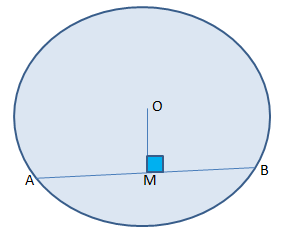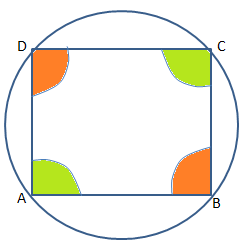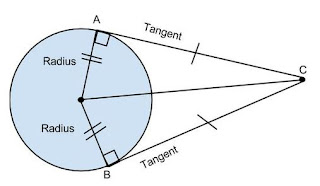Properties of the circle
Circle properties and formulas, properties of circle class 10, properties of circle class 9, easy definition of circle, types of circle, tangent, secant to the circle, cyclic quadrilateral and its properties.
In this chapter we will discuss the following:
Definition of Circle, Radius, Diameter, Chord, Segment, Sector, Cyclic Quadrilateral, their Definitions, Properties of Circle, Properties of Cyclic Quadrilateral with complete explanations.
 CIRCLE:-
CIRCLE:-
Collection of all points in a plane which are at the equidistant from the fixed point, is called a circle.
The fixed point is called centre and fixed distance is called radius.
RADIUS:-
A line segment which join the centre with any point on the circle is called radius.
DIAMETER:-
A line segment which join any two points on the circle and is passes through the centre of the circle is called the diameter of the circle.
Diameter is the double of radius.
Longest chord of the circle is called its diameter.
CHORD:-
Any line segment which join any two points on the circle is called its chord.
Diameter of the circle is also the chord of the circle.
SECTORS:-
Area between the radius and arc is called sector of the circle.
Sectors are of two types: Minor sector and Major Sector
Minor Sector : Smaller sector is called minor sector.
Major Sector : Larger area is called major sector.
SEGMENT :-
Area between the chord and arc is called segment.
Segments are of two types : Minor Segment and Major Segment.
Minor Segment : Smaller area is called minor segment.
Major Segment : Larger area is called major segment.
PROPERTIES OF CIRCLE:-
- Equal chords of the circle subtend equal angles at the centre of the circle.
- If two chords subtend equal angles at the centre of the circle then the chords are equal.
- There is only one circle passes through the three non-collinear point.

-
- Two circles can intersect each other at the most two points.
- Perpendicular from the centre to the chord bisect the chord.
If OM 丄 AB, then AM = BM
If AM = BM, then, OM 丄 AB
- A line segment joining centre of the circle with the mid - point of the chord is perpendicular to the chord.
- Angle made by an arc at the centre is double the angle made by the same arc in the remaining part of the circle.
- Angles in the same segment of the circle are equal.
CYCLIC QUADRILATERAL:-
A quadrilateral whose all vertices lie on the circle is called a cyclic quadrilateral.
PROPERTIES OF CYCLIC QUADRILATERAL:-
Opposite angles of a cyclic quadrilateral are supplementary (180 degree).
ㄥA + ㄥC = 180o , ㄥB + ㄥD = 180o
Exterior angle of a cyclic quadrilateral is equal to the interior opposite angle.
ㄥCBE = ㄥD
TANGENTS TO A CIRCLE
Tangent Line
If a line touch the circle at one point then it is called tangent to the circle.Secant Line :
If a line intersect the circle at two points then the line is called section.
PROPERTIES OF TANGENT TO THE CIRCLE
Tangent is always perpendicular to the radius of the circle.
Length of the tangents from the exterior points to the circle are equal.
Important Result
Relation between Area and Perimeter of a triangle with the radius of incircle
Incircle :- It is
the circle inscribed inside the triangle whose centre is at equidistant from
the sides of the triangle.
\[\frac{Area\;
of\; triangle}{semi\; \; perimeter\; of\; the\; triangle}=Radius\; of\; the\;
in circle\]
Algorithm to solve such problems
1) Find the perimeter of the triangle and then semi-perimeter.
2) Find area of the triangle. If it is an isosceles triangle then use Heron's Formula.
3) Use the above formula to find the required result.
PROOF OF IMPORTANT THEOREMS ON THE CIRCLE
THEOREM 10.1 CHAPTER 10 CLASS 10
Statement :
Tangent is always perpendicular to the radius at the point of contact.
Given: In circle C(o,r), XY is tangent to the circle at point P.
To Prove: OP ⊥ XY
Construction :
Take any arbitrary point Q (other than P ) on the line XY and join OQ which meet the circle at point R.
Proof:
In order to prove that OP ⊥ XY it is sufficient to prove that OP is the smallest line segment than all the line segments obtained by joining O with any point on XY.
OP = OR ..........
(Equal radii)
Now OQ = OR + RQ
OQ = OP + RQ
Subtract RQ from the
R.H.D. we get
OQ > OP or
OP < OQ
But Q is an arbitrary
point on XY
⇒ OP is the smallest line
segment and smallest line segment is always perpendicular.
Hence OP ⊥ XY
Hence prove the required
theorem
THEOREM 10.2 CHAPTER 10 CLASS 10
Statement
Prove that length of tangents from external point to the circle are equal in length.
Given : AC and BC are two tangents from external point to the circle.
To Prove : AC = BC
Construction: Join OA, OB and OC
Proof:
Since radius is always perpendicular to the tangent.
∴ ㄥ1
= ㄥ2 = 90o
In ΔAOC and ΔBOC
OA = OB ............... (Equal radii)
OC = OC .............. (common side)
ㄥ1
= ㄥ2 .............. (Each = 90o
∴ By
RHS ≌ rule
ΔAOC ≌ ΔBOC
⇒ AC
= BC .............By CPCT
Hence prove the required result
Results of other important theorems on circle
Angle made by the chord of the circle with the tangent of the same circle (at the point of contact of the chord and tangent) is equal to the angle made by the chord in the alternate segment of the circle.
If AB and CD are two chords of the circle intersect each other at point p inside or outside the circle then:-
PA X PB = PC X PD
Inside the circle Outside the circle
If chord AB of a circle intersect the tangent of the same circle at point P outside the circle then
PA X PB = PT2
THANKS FOR YOUR VISIT
CIRCLE - CBSE Mathematics



























Thanks for the information sir... it provides a lot of knowledge
ReplyDeleteThanks for wriiting
ReplyDeleteThank you sir! Its very helful
ReplyDeleteIt helps a lot sir
ReplyDeleteThanks for simplifying the term. It was easy to follow.
ReplyDelete